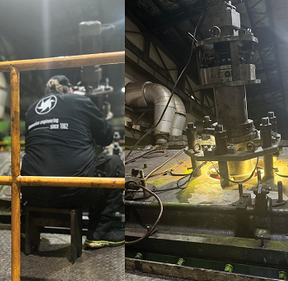Successful completion of the Petronas Floating LNG facility (PFLNG) Satu is a milestone for the oil and gas industry and for the Malaysian energy giant.
Designed by consortium leader TechnipFMC and fabricated at the Daewoo Shipbuilding and Marine Engineering yard in South Korea, PFLNG Satu achieved the first-ever production of LNG offshore in December 2016.
The 365-meter by 60-meter facility processes, produces and offloads LNG in situ, directly above natural gas reservoirs. FLNG allows the monetization of remote, marginal and stranded offshore gas fields that cannot be developed economically via conventional means. This novel approach avoids the expense and potential environmental impact of building and operating long-distance pipelines and extensive onshore infrastructure.
Located on the Kanowit gas field 180 kilometers off Bintulu, Sarawak, Malaysia, PFLNG Satu will produce 1.2 million tons of LNG annually over its 20-year design life. The facility’s topside consists of 22 modules that comprise gas treatment, liquefaction, storage and offloading systems. All of these systems have been installed on top of a hull that is longer than the Eiffel Tower is tall.
The core of PFLNG Satu is a system that liquefies natural gas to minus 163 degrees Celsius using a new process that shrinks the LNG volume by up to 600 times. A two-row arrangement of eight membrane-type LNG cargo containment systems and two condensate storage tanks is located below deck. The tanks can store up to 177,000 cubic meters of LNG and 20,000 cubic meters of condensate with a total storage capacity equivalent to about 79 Olympic swimming pools.
PFLNG Satu can accommodate LNG carriers between 130,000 and 157,000 cubic meters.
The combined weight of the facility’s topsides and hull is 132,000 tons, making it six times heavier than a conventional LNG carrier. It houses about 1,600 kilometers of electrical and instrument control cables, equal to the distance between Berlin and Moscow.
PETRONAS together with the engineering expertise of TechnipFMC and its partners was pivotal to the project’s execution. Detailed design of the topsides and procurement of topside equipment were executed by TechnipFMC’s operating center in Kuala Lumpur, Malaysia, and the hull design was performed at Daewoo’s yard in Okpo, South Korea. Design safety, space constraints, and marinization of equipment to accommodate the motion effects of sea waves, wind, currents, tides and storms were among the greatest technical challenges.
The success of Petronas FLNG Satu can be attributed to a combination of factors including engineering skill, experienced fabricators, efficient interface management, and an experienced and committed project management team. PFLNG Satu achieved first drop of LNG on December 4, 2016, and is moored at its final location and. Once fully operational, the facility will boost Malaysia’s LNG production capacity and change the landscape of the LNG business.
The Author
Serge Dominichini is VP Onshore Offshore, Asia Pacific, TechnipFMC
